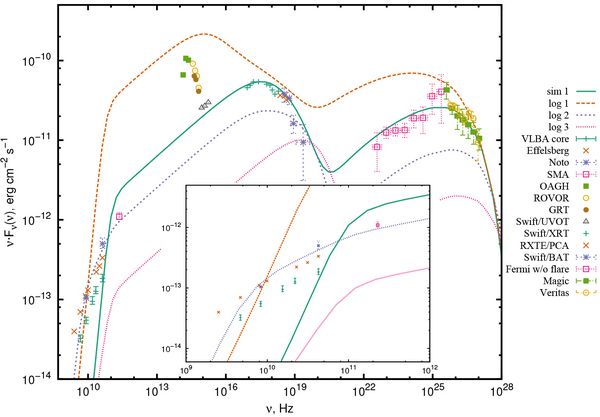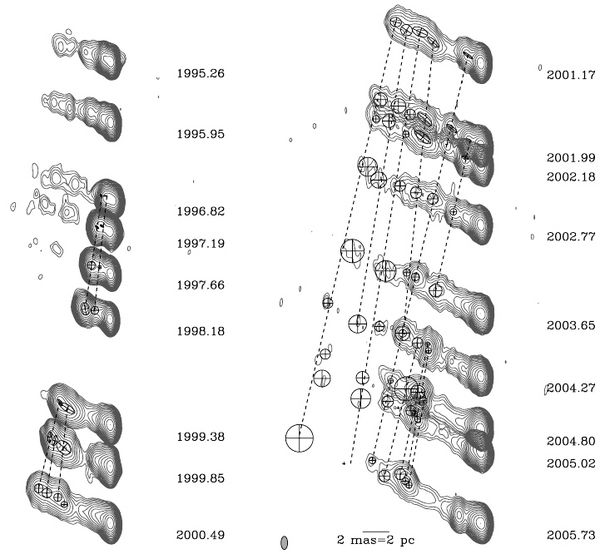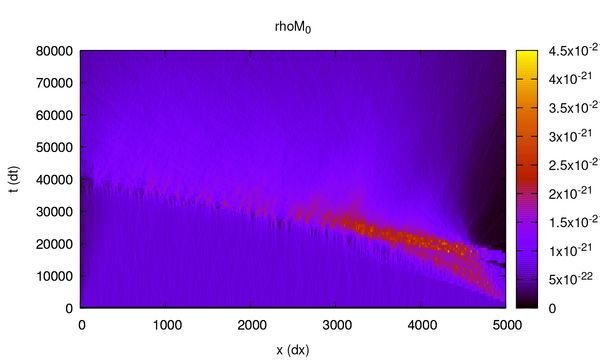ASTROPHYSICS
Numerical Modeling of the Collision of Plasma Blobs in Active Galactic Nuclei
Principal Investigator:
Felix Spanier(1), Anne Stockem-Novo(2)
Affiliation:
(1) Karlsruhe Institut für Technologie, Eggenstein-Leopoldshafen (Germany), (2) Ruhr-Universität Bochum (Germany)
Local Project ID:
pr74se
HPC Platform used:
SuperMUC of LRZ
Date published:
Active galactic nuclei (AGN) are powerful emitters of photons in energy ranges from few millielectron volts (meV) to several teraelectron volts (TeV). These sources show variabilities as fast as a few minutes. It is believed that the emission originates from particles accelerated in shock waves in the jet of AGN. Observational data, however, is too sparse to constrain radiation models. Therefore, light curves (i.e. temporal data) are used to constrain models further. Using the Particle-in-Cell method to investigate shock collisions, this project aims at gaining more detailed insight into a special case of variability.
Active Galactic Nuclei (AGN) are one of the most interesting astronomical source classes. These objects have a supermassive black hole in the center and a large disc of gas around it, which feeds on matter (gas, stars) from the surrounding. Through a not-yet-completely-understood mechanism, a jet forms from this matter, which is ejected perpendicular to the accretion disc (the disc in which material is drawn toward the centre) at speeds very close to the speed of light.
This jet is typically a fully ionized gas – a plasma – confined by a magnetic field. The ionized particles in the magnetic field can produce electromagnetic waves in a very wide energy region (from few millielectron volt to teraelectron volt) and the high speed of the jet boosts this emission, which makes it relatively easy to detect it from Earth. An example is shown in Figure 1.
Understanding how exactly electromagnetic emission is produced in these jets is a typical astrophysical problem: Only very few observations exist, and no laboratory experiment is possible to reproduce the conditions. Therefore, models must be developed and tested against the data to figure out the internal mechanisms. Unfortunately, observational data for AGN is very sparse and is usually not sufficient to derive physical parameters from existing models. For actual meaningful models, it would be necessary to have simultaneous observations from radio frequencies to TeV energies, but there are large gaps in the spectrum, where there are no telescopes available (such as in the MeV range) or it is impossible to coordinate all available telescopes to observe one single source.
There is, however, a further possibility to rule out some of the emission models: The variability of the sources. We can calculate how the emission changes in a certain model under the change of external parameters. This can be compared to the light curve—a measurement of light intensity coming from an object over time.
While this is a good approach to test the model, some questions remain unanswered: Why do external parameters change? What does this change look like?
One very popular model to explain variability is the colliding shock model. Here several shock waves travel at different speeds through the jet (cf. Figure 2) and their collision leads to abrupt changes that can be associated with rapid changes in the emission. The scientific challenge is now that the plasma in the jet is collision-free, meaning it does not behave like a gas, where shock waves interact directly. In fact, shock waves could pass each other without direct interaction. The magnetic and electric fields, however, can interact.
There are various methods to simulate the behavior of collision-free plasmas from which the so-called Particle-in-Cell (PiC) method is currently the most popular. Here, the particles of the plasma are simulated as groups of macroparticles which generate electric and magnetic fields with which the macroparticles interact. This approach is well-suited for highly parallel simulations. While simulations with this approach are well-optimized for supercomputers, there is serious downside in terms of physics: The smallest plasma scales—the Debye length—must be resolved in simulations. For the very-large-scale problems such as those found in astrophysics, this is a major drawback: The numerical size of simulations demands that researchers try to bridge an extremely large gap between the Debye length and the outer length scale. Even the simulation of a single shock wave can use up millions of CPU-hours, which makes the use of supercomputers inevitable.
A very specific problem in this project is the initialization of shock waves. There has been a common approach into starting simulations with only one shock wave, which is the equivalent of throwing plasma blobs against a wall. This approach is not suitable for the injection of a second shock wave. As it turns out, finding a method to inject two shock waves with no artificial noise is the key point and has used up a large fraction of project and computing time.
The key finding of this project has been the specific new method to inject shocks into a numerical simulation without numerical noise. The method has also been published in a renowned peer-reviewed journal. Figure 3 shows the dramatic improvement in the field of shock injection.

Figure 3: The improvement made by using the novel shock injection method developed in the framework of this project. On the left numerical noise moving at the speed of light can be seen. The new method removes this noise completely. The new scheme is based on the Blackman-Harris window, a filtering technique known from Fourier transformation.
Copyright: Klian, P, Spanier, F., Journal of Computational Physics, Volume 353, p. 258-263, 2018This novel method has been used to inject two shocks into the simulation volume. Due to the high speed of the shock fronts, the simulation volume must be extremely large to accurately simulate an overtaking shock front. The results of such a simulation are shown in figure 4. These results show a non-trivial interaction of the two shock waves.
It turns out that with improved injection techniques, the collision can be observed, but the size and resolution are not yet sufficient to provide results useful for scientific questions, even though a single simulation uses almost 10 million CPU-hours. Also, minor technical problems have to be addressed in further simulations, such as correctly filling the simulation volume after the shock injection.
Acknowledgements:
We are grateful for the opportunity to use the Gauss Centre’s HPC infrastruture to perform simulations and we believe that because of it we were able to gain more insight. Further simulations have to be undertaken to answer some of the questions arising from AGN observations, but we are optimistic that with the supercomputing capabilities of the Gauss Centre we will be able to address this challenge.
Research Team:
Felix Spanier1,2, Anne Stockem-Novo3, Parick Kilian4,5, Reinhard Schlickeiser6
1 Centre for Space Research, North-West University, 2520 Potchefstroom, South Africa
2 Now at: Karlsruhe Institut für Technologie, Helmholtzplatz 1, Eggenstein-Leopoldshafen, Germany
3 Lehrstuhl für Theoretische Physik IV, Ruhr-Universität Bochum, 44801 Bochum, Germany
4 Centre for Space Research, North-West University, 2520 Potchefstroom, South Africa
5 Now at: Los Alamos National Lab, USA
6 Lehrstuhl für Theoretische Physik IV, Ruhr-Universität Bochum, 44801 Bochum, Germany
Reference:
7 Klian, P, Spanier, F., Journal of Computational Physics, Volume 353, p. 258-263, 2018
Scientific Contact:
Dr. Felix Spanier
Karlsruhe Institut of Technology
Campus Nord
Hermann-von-Helmholtz-Platz 1, D-76344 Eggenstein-Leopoldshafen (Germany)
e-mail: felix [@] fspanier.de
Project ID: pr74se
May 2019


